Hail Hurts
Resources to Help if Corn and Soybeans Take a Hit From Hail
There's nothing quite like hail to lay your hopes bare. Walking fields stripped by hail in central Illinois this spring, I found myself remembering a long-ago time when my father was caught in the field during a sudden hail event.
The pounding predated tractor cabs, and the pellets came so fast and were so brutal, that he sought shelter beneath the tractor. The bruises that polka-dotted his body from the assault lasted much longer than the storm, but he always said the pain was nothing like emerging after the storm to look upon the tattered crop.
He was also fond of saying the only real way to avoid hail is to buy hail insurance (insert smiley face). Dad has lots of sayings.
Storms over the past few weeks have dished out some traumatic hail events in several states. There are some good resources to help assess what it means if you've been hammered by hail or simply have an interest in what it might mean to yield.
My favorite go-to resource comes from the University of Nebraska's "Hail Know" Team. That clever title is enough for me to give it a thumbs up, but this online guide to all things hail-related covers everything from how to assess damage to how to work with your insurance agent to whether a cover crop can help as a post hail option.
Find the easy way to access reports and videos here: https://cropwatch.unl.edu/…
There wasn't enough left of the hail-beaten baby beans I saw last week to take a photo of. But after reading Nebraska's guide, I reassessed and wonder if the larger beans have a fighting chance. The plants had just begun to bloom, and even though a lot of plant material had been stripped, there appeared to be viable nodes on many plants. Viewing them reminded me of a more violent type of experiment soybean yield king Kip Cullers used to discuss about taking a weed whacker to encourage branching.
P[L1] D[0x0] M[300x250] OOP[F] ADUNIT[] T[]
The Nebraska group noted in a release late last week that hail damage evaluations change as the crop moves past the V6 stage in corn and into the reproductive stages of soybeans.
Find that write up here: https://cropwatch.unl.edu/…
One thing is for certain, hail damage requires some mental fortitude to wait and give the crop a chance to recover, said Dan Quinn, Purdue University corn specialist.
"It really takes four to five days to see how corn is going to come back. It depends a lot on how tight the leaves were rolled, stage of crop -- kind of the same as we say with flattened corn. Give the crop a chance," Quinn said.
Corn smut and bacterial diseases are the main worry with corn following a hail event, Quinn said. "However, there's been a lot of research done to show that fungicides do not help corn after a hail event," he added. "I know a lot of farmers swear by doing that, but we have never seen a response because fungicides generally do not control corn smut and bacterial diseases."
As the plant closes in on pollination, leaf defoliation becomes more of a concern, but Quinn recommended checking in with your crop insurance agent as soon as a wind or hail event happens. Taking stand counts early in the season is a great practice to establish a baseline. Taking photos as soon as possible after the hail event to document damage and continued documentation throughout the season are also recommended.
One thing to keep in mind according to the University of Nebraska writings is the importance of understanding the method being used to estimate growth stages when working with insurance. For example, they noted that the horizontal leaf method of staging is used by the National Crop Insurance Service (NCIS) -- it counts all visible leaves where the tip of the leaf points below the horizontal position, compared to the often-used university method of counting collared leaves.
The University of Nebraska hail documents state that 70% of Nebraska hail events occur from May to July, with 30% of those occurring in June.
DTN's ag meteorologist John Baranick said unfortunately the risks for hail depend on where you live. "The greatest risks for severe hail in the U.S. occur in the Plains states from early March through mid-August, especially from mid-April through June. The risk of greatest probability shifts from the Southern Plains in March through May, to the Central and Northern Plains June through mid-August. Kansas remains in the higher probability zone throughout the main 'hail season'," Baranick noted.
I'd never heard the term "white combine" until I visited Kansas, but Mary Kennedy on our staff wrote about it last year https://www.dtnpf.com/…. She was writing about a report detailing hail damages https://www2.dtn.com/….
I'm putting hail right there on the list with mosquitos, buffalo gnats, giant hogweed and a few other natural things that don't play nice.
For a bulletin from Purdue University on hail damage go to: https://www.agry.purdue.edu/…
For more information on wind damage in crops, go to: https://www.dtnpf.com/…
Pamela Smith can be reached at Pamela.smith@dtn.com
Follow her on Twitter @PamSmithDTN
(c) Copyright 2021 DTN, LLC. All rights reserved.




